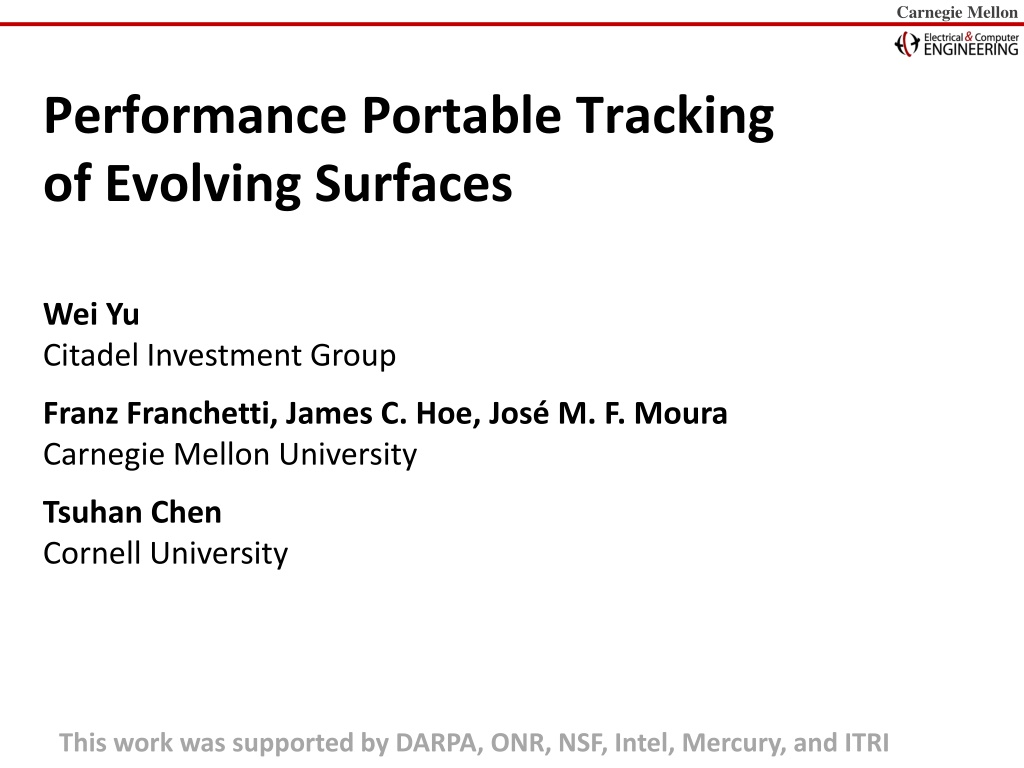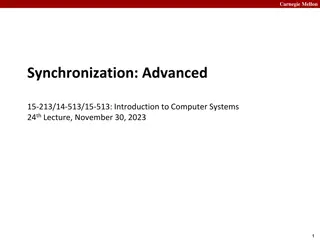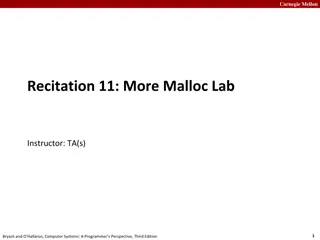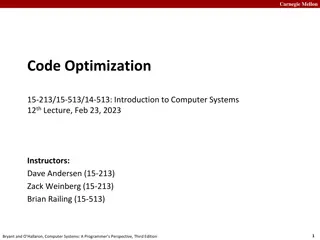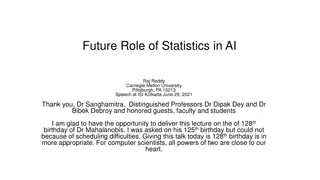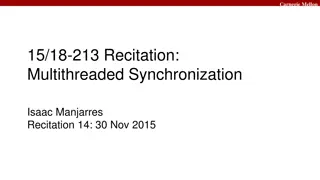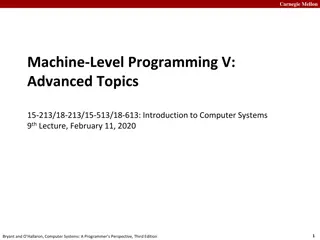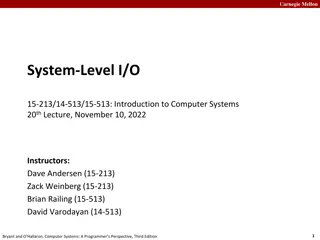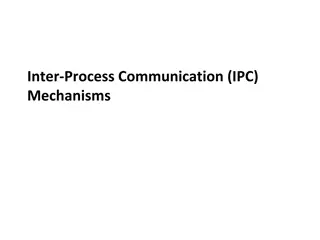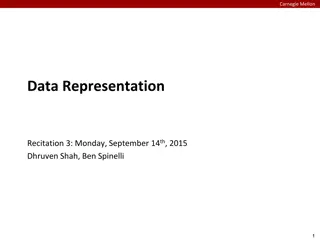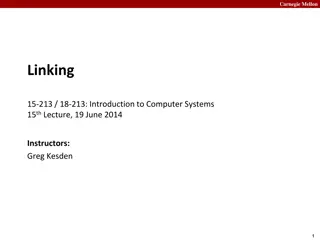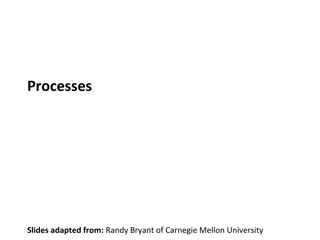Innovations in Performance Computing at Carnegie Mellon
Carnegie Mellon University is at the forefront of performance computing innovations, focusing on portable tracking of evolving surfaces, parallel and heterogeneous computing, software evolution, and compiler optimizations. They delve into the slow pace of change in programming languages, popular libraries, and productivity/scripting languages. The fundamental problem of compilers is explored in matrix-matrix multiplication, along with autotuning and program synthesis for various domains like quantum chemistry and linear algebra. Industry collaborations and support from DARPA, ONR, NSF, Intel, and others drive their cutting-edge research.
Download Presentation

Please find below an Image/Link to download the presentation.
The content on the website is provided AS IS for your information and personal use only. It may not be sold, licensed, or shared on other websites without obtaining consent from the author. Download presentation by click this link. If you encounter any issues during the download, it is possible that the publisher has removed the file from their server.
E N D
Presentation Transcript
Carnegie Mellon Carnegie Mellon Carnegie Mellon Performance Portable Tracking of Evolving Surfaces Wei Yu Citadel Investment Group Franz Franchetti, James C. Hoe, Jos M. F. Moura Carnegie Mellon University Tsuhan Chen Cornell University This work was supported by DARPA, ONR, NSF, Intel, Mercury, and ITRI
Carnegie Mellon Carnegie Mellon Carnegie Mellon The Future is Parallel and Heterogeneous 2012 and later Intel Larrabee Intel Sandy Bridge 8-way float vectors Sun Niagara 32 threads 2009 Virtex 5 FPGA+ 4 CPUs Xtreme DATA Opteron + FPGA Cell BE 8+1 cores Intel Haswell vector coprocessors IBM POWER7 2x8 cores before 2000 multicore IBM Cyclops64 80 cores CPU platforms BlueGene/Q SGI RASC Itanium + FPGA Core2 Duo Core2 Extreme Tilera TILEPro 64 cores Nvidia GPUs 240 streaming cores Nvidia Fermi ClearSpeed 192 cores AMD Fusion Programmability? Performance portability? Rapid prototyping?
Carnegie Mellon Carnegie Mellon Carnegie Mellon Software s Slow Pace of Change Popular performance programming languages 1953: Fortran 1973: C 1985: C++ 1997: OpenMP 2007: CUDA Popular performance libraries 1979: BLAS 1992: LAPACK 1994: MPI 1995: ScaLAPACK 1995: PETSc 1997: FFTW Popular productivity/scripting languages 1987: Perl 1989: Python 1993: Ruby 1995: Java 2000: C#
Carnegie Mellon Carnegie Mellon Carnegie Mellon Compilers: The Fundamental Problem Matrix-matrix multiplication for i=1:N for j=1:N for k=1:N C[i,j] += A[i,k]*B[k,j] += Tiled+unrolled+parallelized+SIMDized+prefetching matrix-matrix multiplication #pragma omp parallel for for i=1:NB:N for j=1:NB:N for k=1:NB:N for i0=i:NU:i+NB #pragma prefetch B for j0=j:NU:j+NB for k0=k:NU:k+NB #pragma unroll for k00=k0:1:k0+NU for j00=j0:1:j0+NU #pragma vector always for i00=i0:1:i0+NU C[i00,j00] += A[i00,k00]*B[k00,j00]; Problem: which transformation order? What parameter values? +=
Carnegie Mellon Carnegie Mellon Carnegie Mellon Autotuning and Program Synthesis Synthesis from Domain Math Spiral Signal and image processing, SDR Tensor Contraction Engine Quantum Chemistry Code Synthesizer FLAME Numerical linear algebra (LAPACK) Compiler-Based Autotuning Polyhedral framework IBM XL, Pluto, CHiLL Transformation prescription CHiLL, POET Profile guided optimization Intel C, IBM XL Autotuning Numerical Libraries ATLAS BLAS generator FFTW kernel generator Vendor math libraries Code generation scripts Autotuning Primer
Carnegie Mellon Carnegie Mellon Carnegie Mellon Level-Set Image Segmentation Level Set Algorithm PDE-based image segmentation method Image produces force field on moving contour Embeds contour into n+1 dimensional level-set function Narrow Band Level Set Algorithm Compute only in neighborhood of boundary Makes algorithm computationally tractable but complicated
Carnegie Mellon Carnegie Mellon Carnegie Mellon Target: Cache-Based Multicores COTS Multicore Shared memory (SMP or NUMA) Cache-based memory (L1, L2, L3) SIMD vector instructions (SSE, AltiVec, ) Intel Core i7 8 cores, 2-way SMT IBM POWER7 8 cores, 4-way SMT File:Ultrasparc t3 micrograph.JPG UltarSPARC T3 16 cores, 8-way SMT Intel Atom 1 cores, 2-way SMT
Carnegie Mellon Carnegie Mellon Carnegie Mellon Why A Challenging Problem? SparseMV Narrow Band Level Set Stencil r iter N iter Memory bound compute bound O(1) O(N) dense & regular data structure sparse data with dense substructure sparse & irregular data structure
Carnegie Mellon Carnegie Mellon Carnegie Mellon Approach Understand algorithmic trade-offs Cheaper iterations vs. fewer iterations Computation load vs. algorithm regularity Understand the target hardware What are the costs and trade-offs? What are good implementation choices and tricks? Develop optimized parameterized implementation Parameters should expose machine/algorithm interaction Parameterization may require macros or program generation Autotune the algorithm and implementation parameters Parameter choice is unclear because of algorithm/architecture interaction Autotuning is the last step in aggressive performance tuning 100x gain: Optimized parameterized program: 50x, autotuning: 2x
Carnegie Mellon Carnegie Mellon Carnegie Mellon How to Get Level Set Up To Speed? Sparse Linear Algebra Time Skewing A x y Code generation Auto-tuning switch (case) { case ( ): BI[j-1][i-1]=1; BI[j+1][i+1]=1; break; case ( ): } for (int j=lj; j<=hj; j++) for (int i=li; i<=hi; i++) BI[j][i]=1;
Carnegie Mellon Carnegie Mellon Carnegie Mellon How Far Did We Go? Level 0: simple C program implements the algorithm cleanly Level 1: C macros plus autotuning search script use C preprocessor for meta-programming Level 2: autotuning + scripting for code specialization text-based program generation, specialization Level 3: add compiler technology, synthesize parts internal code representation, standard compiler passes Level 4: synthesize the whole program from scratch high level representation, domain-specific synthesis
Carnegie Mellon Carnegie Mellon Carnegie Mellon Narrow Band Level Set in a Nutshell += ( ( 1 t t , )) x y x y update the level set zero level set at t zero level set at t+1 update the band no converge yes narrow band narrow band Autotuning parameter: narrow band width
Carnegie Mellon Carnegie Mellon Carnegie Mellon Projection of Manifold into Dense Stencil Autotuning parameter: tile size
Carnegie Mellon Carnegie Mellon Carnegie Mellon Projective Time Skewing Standard 1-D dense time-skewing Polyhedral width x Height Time iteration Projective time-skewing 2D row number r0 r1 r2 r3 r6 r4 r5 r6 t0 r0 r1 r2 r3 r5 r6 r4 t0+1 t0+2 r0 r1 r2 r3 r4 r5 r6 t0+3 r0 r1 r2 r3 r5 r6 r4 Autotuning parameter: polyhedral tile size
Carnegie Mellon Carnegie Mellon Carnegie Mellon In-Core Stencil Optimization 4x4 tile left right down up Compute norm Compute level set function store and cmple/cmpge rsqrt load add/sub mul shuffle vector register xmm1 xmm0 1 2 4 4 5 1 1 3 Optimizations Common subexpression elimination Transcendental function approximation (cos by polynomial) SIMD vectorization Instruction scheduling (intra and inter stencil) + + + + vector operation addps xmm0, xmm1 xmm0 6 3 5 7 Autotuning parameter: tile instruction schedule
Carnegie Mellon Carnegie Mellon Carnegie Mellon Multicore Optimization: Software Pipeline Prologue Core 1 Core 2 Steady state Data transfer between cores requires a memory fence Epilogue Autotuning parameter: prologue/epilogue vs. steady state
Carnegie Mellon Carnegie Mellon Carnegie Mellon Narrow Band Update: Program Generation 2x4 rubber stamp Rubber stamp // TILE=4x4, BAND=+/-1 // unroll: 2x4 for (i=0;i<4;i+=2) { b0=&band[Ti+i-1][Tj-1]; b1=&band[Ti+i][Tj-1]; b2=&band[Ti+i+1][Tj-1]; b3=&band[Ti+i+2][Tj-1]; switch (zeropat(Ti+i,Tj)) { ... case PAT(0,1,1,0 0,0,1,0): b0[1]=1;b0[2]=1;b0[3]=1;b0[4]=1; b1[1]=1;b1[2]=1;b1[3]=1;b1[4]=1; b2[1]=1;b2[2]=1;b2[3]=1;b2[4]=1; b3[2]=1;b3[3]=1;b2[4]=1; break; case PAT(...): } // rubber stamp zero level set for (i=0;i<TILE;i++) for (j=0;j<TILE;j++) if (!is_zero(Ti+i,Tj+j)) { for (k=-BAND;k<=BAND;k++) for (m=-BAND;m<=BAND;m++) band[Ti+i+k][Tj+j+m]=1; } Autotuning parameter: rubber stamp unrolling
Carnegie Mellon Carnegie Mellon Carnegie Mellon A Fundamental Tradeoff runtime Narrow band radius
Carnegie Mellon Carnegie Mellon Carnegie Mellon Parameter Space Tuning Parameters Range Tile size {1,2,4,8}x{4,8,16} Band radius {1,2,3,4,5,6,7,8} Polytope size height {2, 4, 8, 16, 24, 32, 48, 64, 80, 96, 128, 160, 192} Polytope size height {2, 4, 8, 12, 16, 32} Enable/disable SIMD, instruction scheduling, approx. cos(), padding, large pages,
Carnegie Mellon Carnegie Mellon Carnegie Mellon Autotuning: Iterative Line Search Iterative Line search Search parameters one by one hold others fixed Multiple refinement iterations Search space is well-behaved Parameter 2 Heuristics Cut search space For instance: DAG scheduling Parameter 1
Carnegie Mellon Carnegie Mellon Carnegie Mellon Efficiency on Single Core 2.8 GHz Xeon 5560 Peak performance (single core) In-core kernel upper bound Full program 8x 33x C base line=best 3rd party code
Carnegie Mellon Carnegie Mellon Carnegie Mellon Speed-Up On 2x 2.8 GHz Quad Xeon 5560 8 threads 4 threads 2 threads
Carnegie Mellon Carnegie Mellon Carnegie Mellon Performance Gain Through Autotuning Atom N270 @ 1.6 GHz 2x Quad Xeon 5560 @2.8 GHz
Carnegie Mellon Carnegie Mellon Carnegie Mellon Speedup Breakdown on 2x Xeon 5560
Carnegie Mellon Carnegie Mellon Carnegie Mellon Lessons From Optimizing Level Set 10x to 100x speed-up is often possible really hard work, specific to the problem Doable with standard tools C compiler, autotuning, and program generation scripts Crucial: extract meaningful parameters capture machine/algorithm interaction, one algorithm a time Many things must be done right SIMD, threading, low-level tricks, specialization, tuning Autotuning gives the last 50% to 2x speed-up the remaining 5x to 50x come from standard optimization
Carnegie Mellon Carnegie Mellon Carnegie Mellon More Information: www.spiral.net www.spiralgen.com
